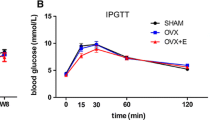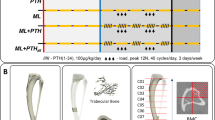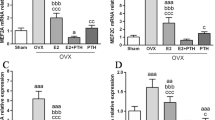Abstract
Recently, basic fibroblast growth factor (bFGF) has been found to increase trabecular bone mass and connectivity in the proximal tibial metaphyses (PTM) in osteopenic rats. The purpose of this study was to determine the bone anabolic effects of bFGF in the lumbar vertebral body (LVB), a less loaded skeletal site with a lower rate of bone turnover than the PTM. Six-month old female Sprague-Dawley rats were ovariectomized (OVX) or sham-operated and untreated for 8 weeks to induce osteopenia. Then group 1 (sham) and group 2 (OVX) were treated subcutaneously (SC) with vehicle, and OVXed groups 3 and 4 were treated SC with PTH [hPTH (1–34) at 40 μg/kg, 5×/week] and bFGF (1 mg/kg, 5×/week), respectively, for 8 weeks. At sacrifice, the fifth LVB was removed, subjected to micro-CT for determination of trabecular bone structure and then processed for histomorphometry to assess bone turnover. The sixth LVB was used for mechanical compression testing (MTS, Bionix 858). The data were analyzed with the Kruskal-Wallis test followed by post-hoc testing as needed. After 16 weeks of estrogen deficiency, there were significant reductions in vertebral trabecular bone volume and trabecular thickness. Treatment with either bFGF or hPTH (1–34) increased BV/TV in OVX animals. Human PTH (1–34)-treated animals had significant increases in trabecular (48%) and cortical thickness (30%) and bone strength [maximum load (53%) and work to failure (175%)] compared to OVX + Vehicle animals. Treatment of osteopenic rats with bFGF increased bone volume (15%), trabecular thickness (13%), maximum load (45%) and work to failure (140%) compared to OVX + Vehicle animals (all P <0.05). Basic FGF increased trabecular bone volume in the lumbar vertebral body of osteopenic rats by restoring trabecular number, thickness and connectivity density. Also, bFGF improved bone mechanical properties (maximum force and work to failure) compared to the OVX + Vehicle group. Therefore, increasing the number, thickness and connections of the trabeculae contributes to increased bone strength in this small animal model of osteoporosis.




Similar content being viewed by others
References
Lane NE, Haupt D, Kinney JH (1997) Estrogen replacement therapy restores trabecular bone volume by altering microarchitecture in the ovariectomized rat. Transactions of the Orthopeadic Research Society, S211
Heaney RP (2003) Remodeling and skeletal fragility. Osteoporos Int 14 [Suppl 5]:12–15
Chavassieux PM, Arlot ME, Reda C, Wei L, Yates J, Menuier PJ (1997) Histomorphometric assessment of the long-term effects of alendronate on bone quality and remodeling in patients with osteoporosis. J Clin Invest 100:1475–1480
Borah B, Dufresne TE, Chmielewski PA, Gross GJ, Prenger MC, Phipps RJ (2002) Risedronate preserves trabecular architecture and increases bone strength in the vertebrae of ovariectomized minipigs measured by 3-dimensional microcomputered tomorgraph. J Bone Miner Res 17:1139–1147
Wronski TJ, Cintron M, Doherty AL, Dann LM (1988) Estrogen treatment prevents osteopenia and depresses bone turnover in ovariectomized rats. Endocrinology 123:681–686
Lane NE, Thompson JM, Strewler GJ, Kinney JH (1995) Intermittent treatment with human parathyroid hormone (hPTH[1–34]) increased trabecular bone volume but not connectivity in osteopenic rats. J Bone Miner Res 10:1470–1477
Wronski TJ, Yen CF, Qi H, Dann LM (1993) Parathyroid hormone is more effective than estrogen for restoration of lost bone mass in ovariectomized rats. Endocrinology 132:823–831
Dempster DW, Cosman F, Kurland ES, Zhou H, Nieves J, Woelfert L, Shane E, Placetic K, Muller R, Bilizekian J, Lindsay R (2001) Effects of daily treatment with parathyroid hormone on bone microarchitecture and turnover in patients with osteoporosis. A paired biopsy study. J Bone Miner Res 16:1846–1853
Paschalis EP, Burr DB, Mendelsohn R, Hock JM, Boskey AL (2003) Bone mineral and collagen quality in humeri of ovariectomized cynomolgus monkeys given rhPTH (1–34) for 18 months. J Bone Miner Res 18:769–775
Lane NE, Sanchez S, Modin G, Genant HK, Pierini E, Arnaud CD (1998) Parathyroid hormone treatment can reverse steroid osteoporosis: results of a randomized clinical trial. J Clin Invest 102:1627–1633
Liang H, Pun S, Wronski TJ (1999) Bone anabolic effects of basic fibroblast growth factor in ovariectomized rats. Endocrinology 140:5780–5788
Pun S, Florio CL, Wronski TJ (2000) Anabolic effects of basic fibroblast growth factor in the tibial diaphysis of ovariectomized rats. Bone 27:197–202
Pun S, Dearden RL, Ratkus AM, Liang H, Wronski TJ (2001) Decreased bone anabolic effects of basic fibroblast growth factor at fatty marrow sites in ovariectomized rats. Bone 28:220–226
Wronski TJ, Ratkus AM, Thomsen JS, Vulcan Q, Mosekilde L (2001) Sequential treatment with basic fibroblast growth factor and parathyroid hormone restores lost cancellous bone mass and strength in the proximal tibia of aged ovariectomized rats. J Bone Miner Res 16:1399–1407
Iwaniec UT, Mosekilde L, Mitova-Caneva NG, Thomsen JS, Wronski TJ (2002) Sequential treatment with basic fibroblast growth factor and PTH is more efficacious than treatment with PTH alone for increasing vertebral bone mass and strength in osteopenic ovariectomized rats. Endocrinology 143:2515–2526
Lane, NE, Yao W, Kinney JH, Modin G, Balooch M, Wronski T (2003) Both hPTH (1–34) and bFGF increase trabecular bone mass in osteopenic rats, however they have different effects on trabecular bone architecture. J Bone Miner Res 18:2105–2115
Jiang Y, Zhao J, Mitlak BH, Wang O, Genant HK, Eriksen EF (2003) Recombinant human parathyroid hormone (1–34) (teriparatide) improves both cortical and cancellous bone structure. J Bone Miner Res 18:1932–194
Laib A, Kumer JL, Majumdar S, Lane N (2001) The temporal changes in trabecular architecture in ovariectomized rats assessed by microCT. Osteoporos Int 12:936–941
Lane NE, Kumer JL, Majumdar S, Khan M, Lotz J, Steven RE, Klein R, Phelps KV (2002) The effects of synthetic conjugated estrogens, A (Cenestin) on trabecular bone structure and strength in the ovariectomized rat model. Osteoporosis Int 13:816–823
Hildebrand T, Rüegsegger P (1997) A new method for the model independent assessment of thickness in three-dimensional images. J Microsc 85:67–75
Maeda H, Kimmel DB, Raab D, Lane NE (1993) The musculoskeletal response to immobilization and recovery. Bone 14:153–159
Parfitt AM, Drezner MK, Glorieux FH, Janis JA, Malluche H, Meunier PJ, Ott SM, Recker RR (1987) Bone histomorphometry: standardization of nomenclature, symbols and units. Report of the ASBMR Histomorphometry Committee. J Bone Miner Res 2:595–610
Parfitt AM, Matthews CHE, Villanueva AR, Kleerekoper M, Frame B, Rao DS (1983) Relationships between surface, area, and thickness of iliac trabecular bone in aging and in osteoporosis. J Clin Invest 72:1396–1409
Linde F, Gothgen DB, Hvid I, Pongsoipetch B (1988) Mechanical properties of trabecular bone by nondestructive compression testing approach. Eng Med 17:23–29
Lotz JC, Kroeber MW, Heilmann K, Pericherla K, Kimmel D, Kinney JH, Lane NE (2000) Tibial plateau fracture as a measure of early estrogen-dependent bone fragility in rats. J Orthopaed Res 18:326–332
Lane NE, Yao W, Kumer J, Breuning T, Wronski T, Modin G, Kinney JH (2002) Basic fibroblast growth factor partially restores trabecular bone architecture in osteopenic ovariectomized rats. Osteoporosis Int 14:374–382
Faulkner KG, McClung M, Cumming SR (1994) Automated evaluation of hip axis length for predicting hip fracture. J Bone Miner Res 9:1065–1070
Duan Y, Parfitt M, Seeman E (1999) Vertebral bone mass, size and volumetric density in women with spinal fracture. J Bone Miner Res 14:1796–1802
Ito M, Nishida A, Koga A, Ikeda S, Shiraishi A, Uetani M, Hayashi K, Nakamura T (2002) Contribution of trabecular and cortical components to the mechanical properties of bone and their regulating parameters. Bone 31:351–358
Van der Meulen MCH, Jepsen KJ, Mikic B (2001) Understanding bone strength: size isn’t everything. Bone 29:101–104
Bell GH, Dunbar O, Beck JR, Gibb A (1967) Variations in strength of vertebrae with age and their relation to osteoporosis. Calcif Tissue Int 1:75–86
Parfitt AM, Mathews CHE, Villanueva AR, Kleerekoper M, Frame B, Rao DS (1983) Relationship between surface, volume, and thickness of iliac trabecular bone in aging and osteoporosis. J Clin Invest 72:277–282
Lane NE, Haupt D, Modin G, Kinney JH (1998) The acute changes in trabecular bone connectivity and osteoclast activity in a rat model of estrogen deficiency. J Bone Miner Res 13:229–236
Qi H, Li M, Wronski TJ (1995) A comparison of the anabolic effects of parathyroid hormone at skeletal sites with moderate and severe osteopenia in aged ovariectomized rats. J Bone Miner Res 10:948–952
Recker RR (1993) Architecture and vertebral fracture. Calcif Tissue Inc 53:s139–s142
Ito M, Nishida A, Koga A, Ikeda S, Shiraishi A, Uetani M, Hayashi K, Nakamura T (2002) Contribution of trabecular and cortical components to the mechanical properties of bone and their regulating parameters. Bone 31:351–358
Pothuaud L, Rietbergen BV, Mosekilde L, Beuf O, Levitz P, Benhamou CL, Majumdar S (2002) Combination of topological parameters and bone volume fraction better predicts the mechanical properties of trabecular bone. Bone 35:1091–1099
Ulrich D, Rietbergen BV, Laib A, Rüegsegger P (1999) The ability of three-dimensional structure indices to reflect mechanical aspects of trabecular bone. Bone 25:55–60
Wachter NJ, Augat P, Mentzel M, Sarkar MR, Krischak GD, Kinzi L, Claes LE (2001) Predictive value of bone mineral density and morphology determined by peripheral quantitative computed tomography for cancellous bone strength of the proximal femur. Bone 28:133–139
Thomsen JS, Ebbesen EN, Mosekilde L (2002) Predicting human veterbral bone strength by vertebral static histomorphometry. Bone 30:502–508
Ikeda S, Tsurukami H, Ito M, Sakai A, Sakata T, Nishida S, Takeda S (2001) Effects of trabecular bone turnover contour on ultimate strength of lumbar vertebra after bilateral ovariectomy in rats. Bone 28:625–633
Author information
Authors and Affiliations
Corresponding author
Additional information
This work was supported by grants from the NIH 1R01AR43052 and the Rosalind Russell Arthritis Research Center.
Rights and permissions
About this article
Cite this article
Yao, W., Hadi, T., Jiang, Y. et al. Basic fibroblast growth factor improves trabecular bone connectivity and bone strength in the lumbar vertebral body of osteopenic rats. Osteoporos Int 16, 1939–1947 (2005). https://doi.org/10.1007/s00198-005-1969-2
Received:
Accepted:
Published:
Issue Date:
DOI: https://doi.org/10.1007/s00198-005-1969-2




